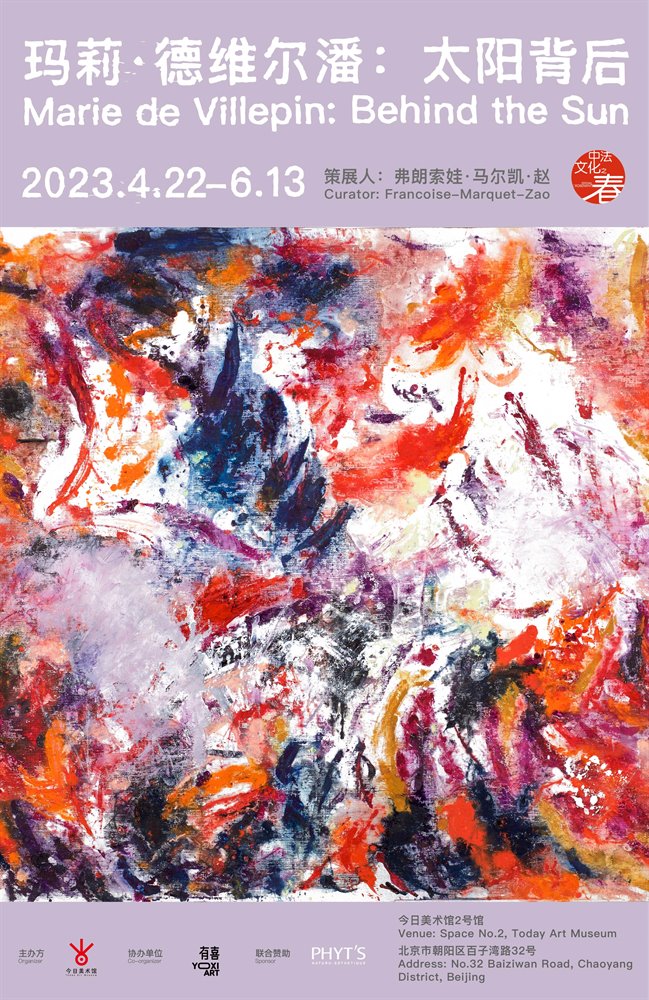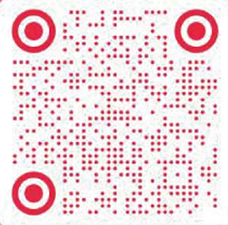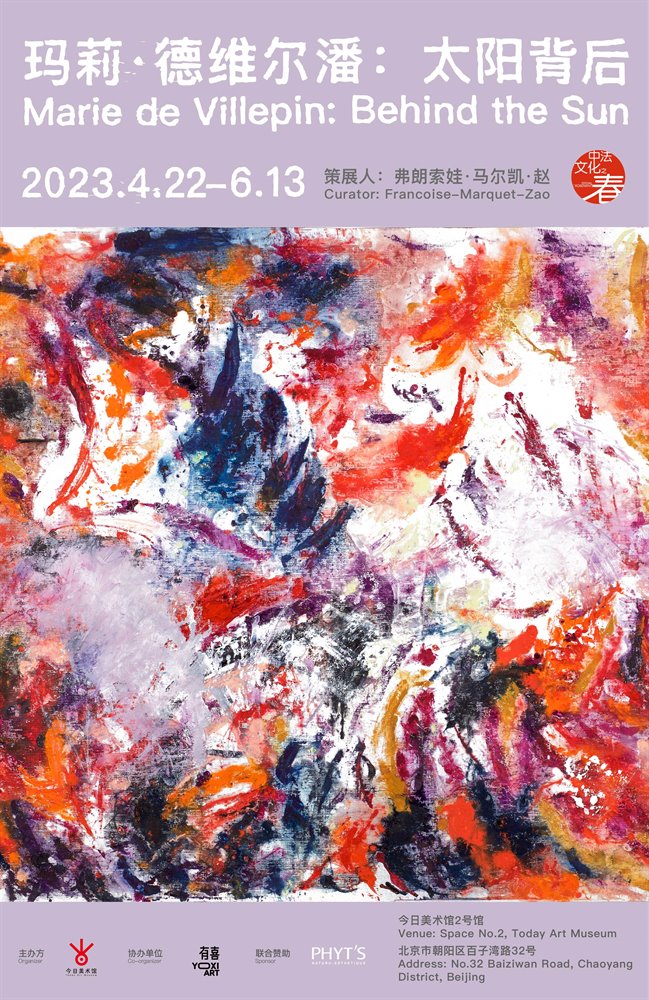
Preface
Marie de Villepin – Behind the sun
Behind the sun is where infinity begins: we appreciate that the sun still exists, indeed everywhere, and yet behind the sun, it no longer illuminates anything; its rays are lost in a long wander without fortuity. There lies the edge of what Liu Cixin would call the Dark Forest, this universe where all communication becomes imprecation, where the entirety of civilization would “glide amongst the woods like a ghost, somewhat lifting up the branches on its way, striving not to make any noise with its footsteps.” There, amongst the stars, move Marie’s canvases, at times with the serenity of “music of the spheres”, other times with the explosiveness of desperate rage typical of heavy metal. Let us be guided by, for instance, Planet Caravan II, which casts lanternfish into the depth of the sea, where pitch-black creeps in everywhere, obscures the shapes, and stretches out like clouds shrouding mountain valleys. Colors still survive, but diminished, almost stifled; this nomadic caravan leads us towards the bottom of the sea, as if in the dark of the night, with starlight as the sole guide, towards these endless spans where we are vagabonds and wanderers, as in Black Sabbath, when the languid, distant, and muffled voice of Ozzy Osbourne announces by way of a ballad melody, nearly a lullaby:
“We sail through endless skies
Stars shine like eyes
The black night sighs
The moon in silver trees
Falls down in tears
Light of the night”
太阳的背后是无限的开始——我们知道,太阳仍然存在,但在太阳背后,它不再照耀任何东西;它的光线在漫长的徘徊中迷失。以刘慈欣的话语来形容,这里就是黑暗森林的边缘,一个所有通信都将变成诅咒的宇宙;在那里,所有文明都像幽灵一样穿行在树林之间,轻轻地掀起挡路的树枝,尽力不发出脚步声。玛莉的画作在星际之间来回穿梭,有时像「 星球之歌」般平静,有时像重金属摇滚的绝望般狂暴;让我们以《星球拖车之二》为例,灯笼鱼在深海中游荡,在那里漆黑一片,轮廓变得模糊,像云彩一样笼罩着山谷。色彩仍然存在,但已经被削弱,几乎被扼杀。仿如游牧民族的车队,带领我们深入海底,深入黑夜的中心,只有微弱的星光作为向导,带领我们进入这无尽的空间,因而成为流浪者和漂泊者,就像歌曲《黑色安息日》中,奥齐·奥斯本以低沉、遥远且压抑的嗓音唱出犹如摇篮曲的歌谣旋律:
我们在无尽的天空中航行
星星如眼睛般闪烁着光芒
黑夜叹息着
月亮在银色的树林中
落下泪来
夜之光
This agency of light takes an unprecedented form in the exhibition at the Today Art Museum in Beijing, the largest exposition of Marie’s works to date, an impressive specimen of her experiments with and research on colors, shapes, and experiences. Marie’s paintings are, therefore, space without distance as much as they are infinity captured in the frame of a rectangle; with so many windows open to the light of other possible worlds, which retain, capture, tame, and feed it with colors. The revelation of light often comes from shock. As evidenced by one of her latest and most exhilarating paintings, Things behind the Sun. It shows a dimension of research on or experiment with the way color is approached, as if it were a question of confronting every single avatar of the visible world, so as to grasp how colors take shape, rise up, and set themselves in motion. There, colors are evoked, as if in a rite. It feels like leaping into hyperspace, while the palette continues to flourish. Blue dominates here, and it constitutes the backbone of much of Marie de Villepin’s oeuvre. Luminous shades of red emerge from the edges of the painting, opening up a battlefield, a struggle between elements vying for an uncertain victory. The clash of colors creates depth and space, keeping the battlefield open like a retractor in the unhealable wound that is the eye.
这种光的特性在是次展览中得到前所未有的体现,这也是迄今为止玛莉·德维尔潘在中国规模最大的个展,全面展现她对颜色、形状和经历的实验和探索。玛莉的画作是没有距离的空间,亦是在矩形框架中被捕获的无限;它们是打开通往其他可能世界的光芒之窗;它们保留、捕捉并驯服光线,用色彩滋养它。光的启示往往来自冲突,这在她最新、最令人兴奋的一幅画作《太阳背后之物》中得到了证明。这里表达了一种对颜色的探索和实验的维度,仿佛需要面对每一个可见的化身,以了解颜色的形成、冒升和运动。颜色如仪式般被唤起,感觉犹如纵身跳入超空间。色板不断繁衍,蓝色逐渐占领主导,构成玛莉作品中的重要解构。明亮的红色色调从画面边缘突然出现,开拓另一战场,各个元素之间的斗争结局胶着。颜色的对抗创造出深度和空间,保持空间的开放性,就像无法愈合的伤口。

The first junction immediately presents itself, that of two symmetrical tunnels, dug with bare hands over numerous generations of art in the West, namely drawing and color, indeed rivals vying to accomplish mimesis, or the imitation of reality. One might be tempted to believe that Marie leans entirely towards color. In her way of painting, by successive layers and touches, Marie appears to sculpt colors. Her paintings are born, and do live and think in terms of color. Starting from the organization of patterns on canvas, she identifies radiation, repetition, and remanence. Colors are not values attributed to objects, not even to emotions, but notes with which chords, melodies, and refrains are composed. Throughout her canvases, colors sing. Oftentimes, a sustained, reinforced dominance emerges, illuminated by other shades of color, like a visual scaffolding. Like an A major, blue offers the quiet and solemn radiance of an envelopment; like a D major, red presents something triumphant, at times joyful, other times explosive; and like a B minor, violet provides a wealth of variations on a slow and melancholic theme with unhealthy flourishes, as in Mauve Fauve.
第一条分支立即呈现,那是两个对称的空间,即西方艺术经过多个世代,徒手挖掘出来的地道:绘画和色彩。它们竞相完成对现实的模仿,即古希腊哲学所指之摹仿。我们可能以为玛莉完全倾向于色彩,从她的绘画方式来看,通过逐层逐笔的方式,玛莉似乎在雕刻颜色。她的绘画脱胎自颜色,亦以颜色的角度存续并思考。从画布上图案排列开始,她发现了它们的辐射、重复和残留。颜色不是赋予物品或情感的价值,而是音符,通过它们组成和声、旋律和副歌。颜色就在玛莉的布面作品上歌唱,通常会出现一种强烈的主导色调,通过其他色调的加强和照亮,形成一种视觉上的脚手架。蓝色就像A大调,给人一种安静和庄严的包容感;红色就像C大调,带来一种凯旋之感,有时是欢乐的,有时是爆炸性的。又如在《淡紫》中,紫色,是B小调的和弦,像一朵逐渐凋零的花朵,一个缓慢而忧郁其充满变化的主题。

Marie’s painting intrigues and reveals, as much as it is calming and worrying. It is a way of painting that thinks, not by logical articulations or manifest intention, but by enabling thoughts to unfold in it latently. Such thoughts advance by contradiction, tension, and opposition; she thinks in terms of color and composition. These do neither concern the compromises of chiaroscuro, nor are they such a dichotomous logic that excludes the middle, but they represent the courage to embrace the contrast between darkness and lightning. In and within Marie, there is indeed a fight between line and color, or in any case the search for a new harmony, which goes against the tide of the battle begun during the Italian Renaissance, eventually ending in the trenches of Impressionism, Fauvism, or Abstractionism. By proliferating free and rich designs, in which alternate upsurges of figures and rhythmic patterns seem as if the hand is fighting against the pen, line embodies the desire to capture here and now. One has to, it appears, cross the waters in a zig-zag maneuver to escape the spirits in hot pursuit. Marie is perhaps dancing with the spirits, finding her way out and dodging contradictions by embracing them.
玛莉的绘画充满神秘和启示,既让人平静又让人不安。这是一种思考的绘画,并不通过逻辑结构或明确的陈述来表达思想思考却以潜在的方式展开;它通过矛盾、张力和对立来前进,以色彩和构图来思考。这不是明暗对比的妥协思维,也不是非黑即白的逻辑,而是勇敢地拥抱黑暗和闪电的对比。玛莉的画作中存在线条与颜色之间的对抗,或者说是对全新和谐的追求,但这种对抗与始于意大利文艺复兴时期、在印象主义、野兽派或抽象派身后结束的战争背道而驰。线条体现了捕捉此时此刻的渴望,通过繁殖自由且丰富的图案来实现;交替出现的形象以及图案的韵律,则给人一种手指轻拂笔触的感觉。或许,为了避免精灵的追赶,我们不得不以「之」字型曲折地穿过水域。也许玛莉正在与精灵跳舞。通过接受它们来开辟自己的道路,并避免矛盾。
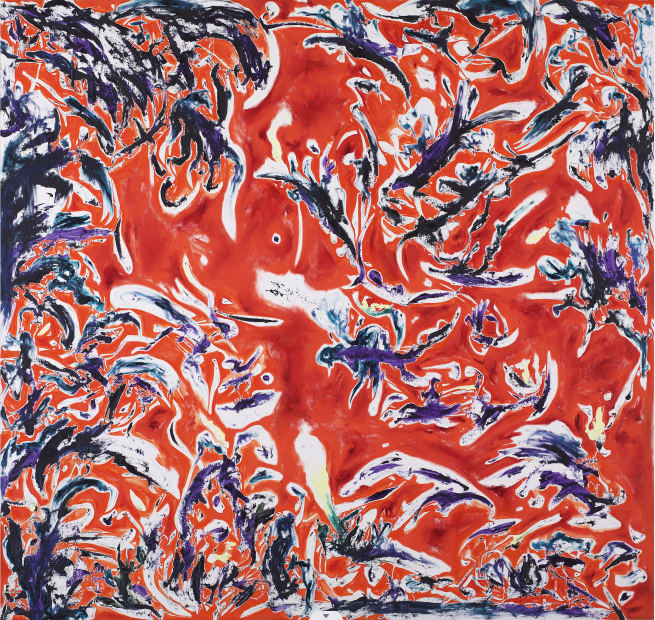
Marie de Villepin guides us to look behind the sun, because this is the one place for the universal, the only viewpoint from which one may reconcile all the world’s views in their particularity, thereby overcoming confinement. To go behind the sun means finally finding this place where both presence and absence are possible; it is the other side of the sun that this exhibition is telling us about, not the falling space in its front, but the place of encounter. It is probably the same place as The Dark Side of the Moon, where it is possible for us spectators to wait for the other to meet the self. As a voice narrates Paul Auster’s 1986 novel The Hidden Chamber: “By belonging to Sophie, I began to feel as though I belonged to everyone else as well. My true place in the world, it turned out, was somewhere beyond myself, and if that place was inside me, it was also unlocatable. This was the tiny hole between self and not-self, and for the first time in my life I saw this nowhere as the exact center of the world.”
玛莉·德维尔潘引领我们观看太阳背后,因为那是唯一的普世之处。只有从这个角度,我们才能调和世间所有观点的特性,从而克服狭隘。穿过太阳意味着同时找到存在与缺失,这就是这个展览所谈到的太阳背后的地方;不是陨落之地——在太阳前面——而是相遇之地。它可能就在月球的背面,我们作为观众,可以等待他者与自身相遇。如同保罗·奥斯特在1986年的小说《隐藏的房间》中说道:「 属于苏菲的时候,我开始感到自己也属于其他所有人。我发现自己在世界上的真正位置,其实是在我之外的某个地方,如果这个位置是在我之内,它也是无法定位的。这是我和非我之间微小的空隙,我生命中第一次意识到,这个虚无之处正是世界的中心。」
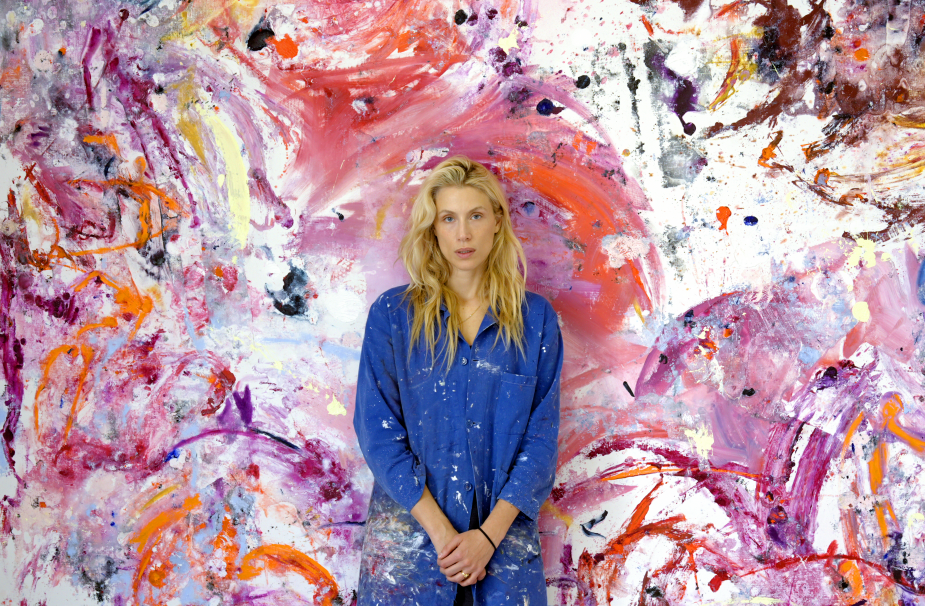
关于艺术家
玛莉·德维尔潘 (Marie de Villepin) 于1986年在华盛顿哥伦比亚特区出生,早年岁月大多于美国和印度等地度过。艺术向来是其成长过程中不可或缺的一环,在以四海为家的经历中,她透过音乐和绘画,来传递自己的内心世界。在数十册的绘本中所承载的是她尝试捕捉岁月及情感的记录。在外交世家长大的玛莉,从小与诗人、音乐家、导演及画家等艺术先躯相处,其中包括家族朋友赵无极。她深受二战后的美国艺术影响,比如威廉·德·库宁(Willem de Kooning)、塞·汤伯利(Cy Twombly)、琼·米切尔(Joan Mitchell)及菲利普·古斯顿(Philip Guston)等艺术大师,尤其欣赏他们在作品中所展现的音乐性、自由精神及跨领域特质。
玛莉于2005年迁往纽约,及后移居洛杉矶。在当地开展多个音乐项目后,她最终决定潜心于绘画中。为着深化对于色彩、声音及节奏之间的联系,她让内心世界转录在画布上,以笔触描绘四周的人事景物,从而摒除流浪、孤独和怀疑的感觉。她的艺术世界逐渐成型,其中包括想像中的风景、生物及各式各样的系统元素,游走于具象和抽象之间。
玛莉·德维尔潘的作品曾在纽约、洛杉矶、北京和香港举办的多个联展中展出。于2019年,她的首次个人展览“新生物”(New Creatures)在巴黎顺利举行,同时亦象征她正式回归艺术之都。在全球疫情渐趋缓和后,她于2022年3月发布了在美国及法国创作的“失去的周末”(The Lost Weekend) 系列。同年6月,玛莉·德维尔潘被评选为十二位获颁安托万·马杭奖(Prix Antoine Mar-in)的青年艺术家之一。该奖项由巴黎胡利奥·冈萨雷斯(Julio Gonzalez)画廊所颁发,参赛者须获得一位国际知名艺术家提名,该提名人为德国新表现主义代表人物之一的安塞尔姆·基弗(Anselm Kiefer)。
关于今日美术馆
成立于2002年的今日美术馆(TAM),是中国内地首个民营非企业公益性美术馆,以促进全球语境“艺术与科技”“艺术与设计”“当代艺术”三个方向的深度探索为主旨,致力于为艺术家、公众和跨学科机构提供开放的交流平台,始终走在激发对话、拓展艺术观念的前沿。

 58届博洛尼亚插画展·中国巡展
58届博洛尼亚插画展·中国巡展 止观:王梓木作品展
止观:王梓木作品展 塞尚·四季:大型沉浸式艺术展
塞尚·四季:大型沉浸式艺术展 “玛莉·德维尔潘:太阳背后”
“玛莉·德维尔潘:太阳背后” “一粒一世界——北京大学颗粒艺术展”
“一粒一世界——北京大学颗粒艺术展” “一粒一世界——北京大学颗粒艺术展”
“一粒一世界——北京大学颗粒艺术展” 弗洛伦泰因·霍夫曼:欢聚!
弗洛伦泰因·霍夫曼:欢聚! 李怒:流沙即磐石
李怒:流沙即磐石 展览定制课|《叶锦添:全观》艺术定制课
展览定制课|《叶锦添:全观》艺术定制课 【今日合唱团招募+强行科普】把蓝瘦菇放进锅
【今日合唱团招募+强行科普】把蓝瘦菇放进锅 今日平移工作室/精雕细刻有尽时
今日平移工作室/精雕细刻有尽时 2019王式廓——今日中国当代青年艺术家国际驻留项目
2019王式廓——今日中国当代青年艺术家国际驻留项目 2018年第三届王式廓奖——当代青年艺术家提名展
2018年第三届王式廓奖——当代青年艺术家提名展 时代渐强音——2017王式廓奖暨今日中国当代青年艺术家提名展
时代渐强音——2017王式廓奖暨今日中国当代青年艺术家提名展
